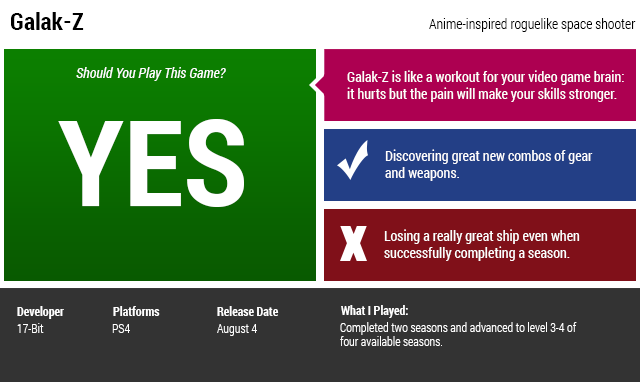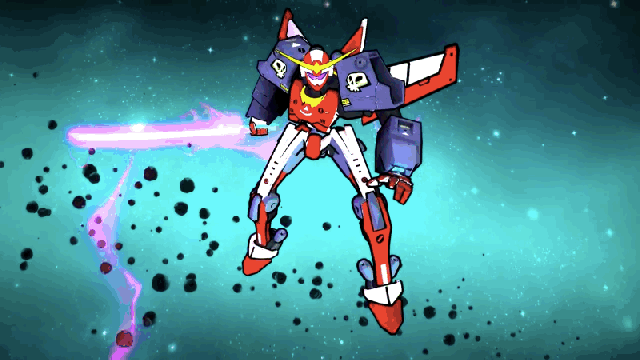One of the tool tips in Galak-Z says, “Death is just part of the circle of life.” That’s true. But, also: screw you, Galak-Z.
Galak-Z feels like how video games used to be. It looks simple but plays hard. You’ll keep telling yourself, “I know I can beat this freaking mission.” You can’t. Not at first anyway. But it’s good enough to keep pulling you back in to try over and over.
http://kotaku.com/ten-things-you…
17-Bit’s procedurally generated sci-fi adventure gives players a homage to decades past, one that feels both self-conscious and unintentional. The game mimics the look and feel of old-school classics like Asteroids or Sinistar, along with paying homage to various anime series that came to the West in the 1980s. Players control the character of Adam “A-Tak” Takamoto, the last surviving pilot of a human interstellar coalition ambushed by bad guys from a hostile alien empire. A-Tak links up with a wayward carrier Axellios and teams up with its crew to try and get back to Earth to warn their home planet of impending doom. Galak-Z gets its name from A-Tak’s spacecraft, a one-of-kind experiment that can switch from ship to mech in the grand ol’ transforming robot tradition.
For all the retro trappings, it’s mostly the game design of Galak-Z that makes it feel like a throwback. As players shoot, slice and fly through the game’s TV season structure, Galak-Z unfurls a series of levels that present all sorts of treasures and threats to players, designed to test bravery and strategy in nerve-wracking ways.
Galak-Z belongs to the roguelike video game sub-genre. Roguelikes tend to spin up their levels from an algorithmically-combined mix of elements. Progress is saved minimally when compared to most modern games. Titles belonging to the genre are also harsher in their game-over punishments, making you replay big chunks without the loot, resources or abilities you lose after dying. Like other roguelikes, the real challenge of Galak-Z is in decoding the language spoken to you in its moment-to-moment challenges without the fallback of a built-in safety net. The work of figuring out the best gear/weapon combos and engagement strategies for multiple enemy types is seductive. But it’s also infuriating.
The infuriating part comes from Galak-Z‘s punishing difficulty. When I started, the loose-feeling controls made the randomly rolled challenges even more daunting, because I had to constantly be aware of ship drift and position when dogfighting it out in tight spaces. But even after I got accustomed to Galak-Z‘s control quirks, I found myself dying a lot. Swarms of enemies made me panic and I slowly learned that my insistence on fighting through every enemy encounter was a dumb move. Stealth is an option here and there’s no shame in sneaking past a stronger ship so you can live another day. If you don’t learn from your mistakes, you’re going to explode into a ball of flames a lot more.
So far, I’ve spent about two weeks with Galak-Z in its various forms. First, I dug into a review-ready pre-release build. Then I re-played the initial season one levels after Galak-Z came out on PlayStation Network last week. At first blush, Galak-Z was in a much rougher state. The game got held up in noticeable hitches and occasionally shuddered into crippling slowdown at times. But the most recent 1.03 patch has greatly improved the game’s performance, making for a much smoother play experience.
What’s tougher to judge is whether the patch has made the game any easier. I spent the better part of last week trying to complete season two, meeting humiliating deaths at the hands of Imperial or Void Raider pilots two or three levels in. After the patch, I was able to push through all of the season’s five episodes in one longer session. Things had clearly changed: enemies were massing at the entrances to dungeons, stronger enemy types showing up sooner, a wider variety of power-ups spawning in the same levels I’d been beating my head against. But I got the sense that difficulty scaled up as I got better at stuff so these changes alone didn’t necessarily pave the way for my increased confidence.
If anything, the aggregate amount of time I’ve spent with Galak-Z has made me more conversant with its particular syntax. Part of it has been remembering that changing from mech to ship in the heat of battle affords different strategies. You could, for example, snatch an electrified piece of wreckage as a mech, lob it at an enemy to instantly pop their shields and change back to blast them with the ship lasers. Or, you could just throw the ships in an enemy patrol at each other until they all explode, conserving precious missile ammo all the while. I learned to use asteroids as shields and throwable weapons using the mech form’s grab ability. Trial and error showed that I could lure enemies into flaming gas pipes and lava pools while protected by the Heatsink power-up’s fireproofing. Two days ago, I let out an audible gasp when I discovered the Nuts and Bolts power-up that restores one unit of health after a completed mission. (Then I choked up after finishing season 2, knowing that the invaluable tool would be going away.) And just last night, I decided that the short, powerful blasts created by the Scatter Muzzle wouldn’t ever work for my playstyle. Bounce shot and pellet particle spread are always great upgrades but they’re not always available when I’d like so best not to rely on those as part of a boss fight plan. I’ve learned to consider what I have on hand — money, weapons, upgrades — and how best to use it to survive for the next five minutes.
You build up your strength and lose it over and over in Galak-Z. An in-game currency called Crash Coins lets you buy upgrades after losing everything after death or season completion, but you won’t be recreating the special alchemy of the ship you were just piloting. Mission types usually have you fetching or destroying stuff, but that’s not the point. The main gameplay goal of Galak-Z is getting loot and outfitting your spacecraft well enough to handle the challenges you’ll face. Every time I died, I wondered about what mix of upgrades might have let me live longer. Plasma Core + Pellet Particles + Bounce Shot + Precision Muzzle? Prioritise boost and thrust upgrades for faster getaways? Max out my missile capacity? Those decisions get complicated by the quirks of the different factions’ varying fleets and ship abilities.
Part of what makes the challenge of Galak-Z bearable are the flourishes in its presentation. The art direction, voicework and soundtrack are all stellar. Different music cues bubble up depending on the enemy factions that creep into an area, so you’ll know what you’ll be facing before making contact. The VCR menu pause screen still makes me laugh and I love that A-Tak is voiced by The Venture Brothers‘ Michael Sinterklaas.

Galak-Z has changed since I’ve played it and my sense of my own skill has changed too. The push and pull of risk/reward is present throughout. The core decision is whether to explore and get loot, or to do objectives and get the heck out of dodge as soon as possible. Or you may feel the need to try and find every chest even if you’re on low health, because who knows what life-saving addition you’ll find in that unexplored chunk of the map. The decisions will change almost constantly, depending on how strong your ship is or how a level is laid out. That mutability is the reason why Galak-Z feels like it deserves the same kind of rabid, meticulous devotion that mushroomed around games like Spelunky. It feels like it has quirks and peculiarities waiting to be sussed out and disseminated. So, yes, go get Galak-Z and add your brain power to the cloud of neurons that will be figuring out best strategies. Together, we’ll survive this thing and we’ll look cool doing it. After a while, it might even seem like we know what we’re doing.

Comments
4 responses to “Galak-Z: The Kotaku Review”
Want to get this at some stage, but plumped for Everyone’s Gone To The Rapture instead, maybe next month!
It’s too bad this won’t make it to the Vita.
I have been really enjoying this.
this game is brutal, but awesome